Abstract
1. The spatial patterns of reflexes elicited by localized pressure stimulation of the foot skin were analysed by recording electromyographic activities of various hindlimb muscles or muscle nerve discharges in cats anaesthetized with sodium pentobarbitone. 2. Reflex discharges evoked by stimulation of the central pad occurred mainly in physiological toe extensors located in the foot. Stimulus-response relationships of single motor units revealed characteristically wide ranges of graded response and recruitment. 3. Within the central pad, the strongest excitation was evoked from the central lobe and was distributed to extensors of all four toes. Excitation from the medial and the lateral lobes was usually asymmetrical and weaker in toe muscles of the stimulated side. It is suggested that the weakness was in part due to concomitant inhibition. 4. Stimulation of a toe pad caused marked suppression of central pad-evoked activity of toe extensors with a highly specific spatial pattern. The inhibition was strongest in extensors of its own toe, and gradually weaker in the more distant toes. Weak excitation was occasionally evoked in extensors of the most medial or lateral toes, when the most lateral or the most medial toe-pad, respectively, was stimulated. 5. A similar pattern of relfex to that from the toe pad was evoked from the claw base and the hairy toe dorsum of each digit. 6. Reflex effects, both inhibitory and excitatory, from the central and toe pads, claw bases and toe dorsum were maintained during prolonged stimuli, indicating that slowly adapting receptors contributed to these reflexes. 7. It is concluded that stimulation of localized skin areas of the foot, particularly the pads, evokes highly specialized reflexes, which may be important in controlling movements of individual digits.
Full text
PDF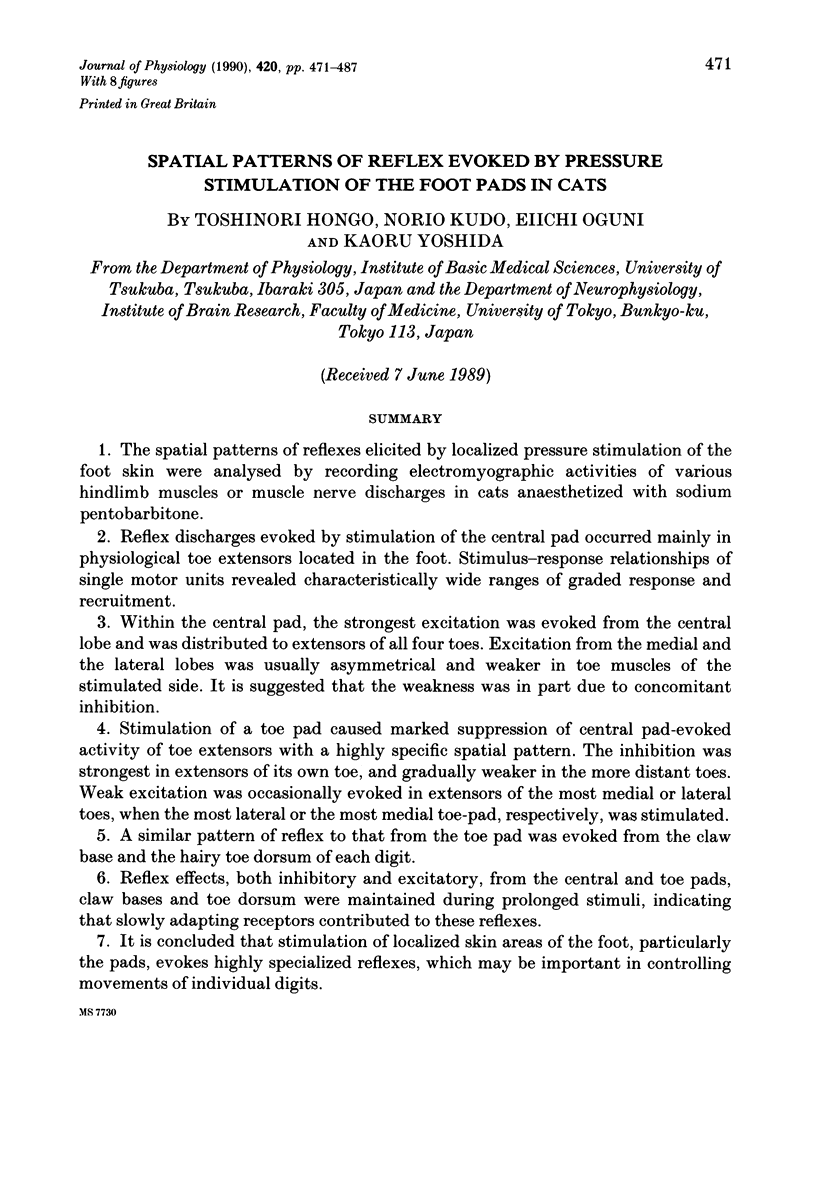

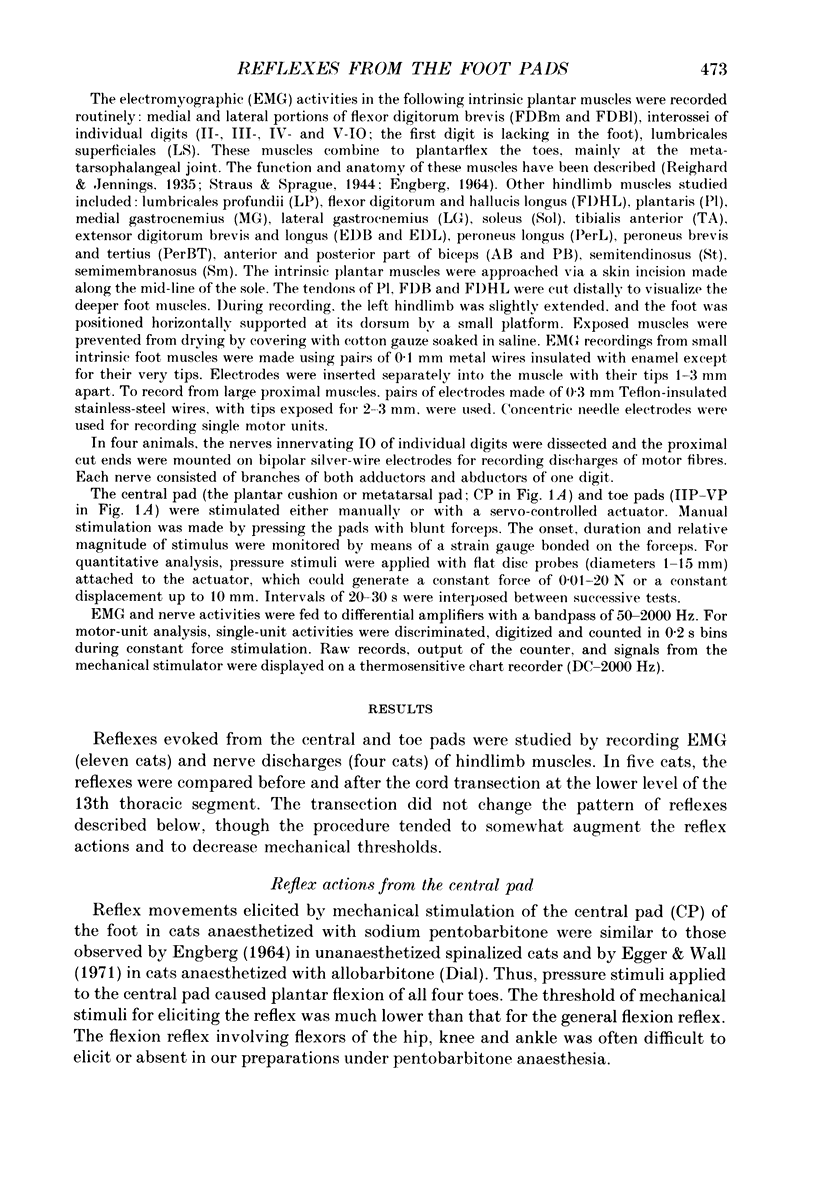
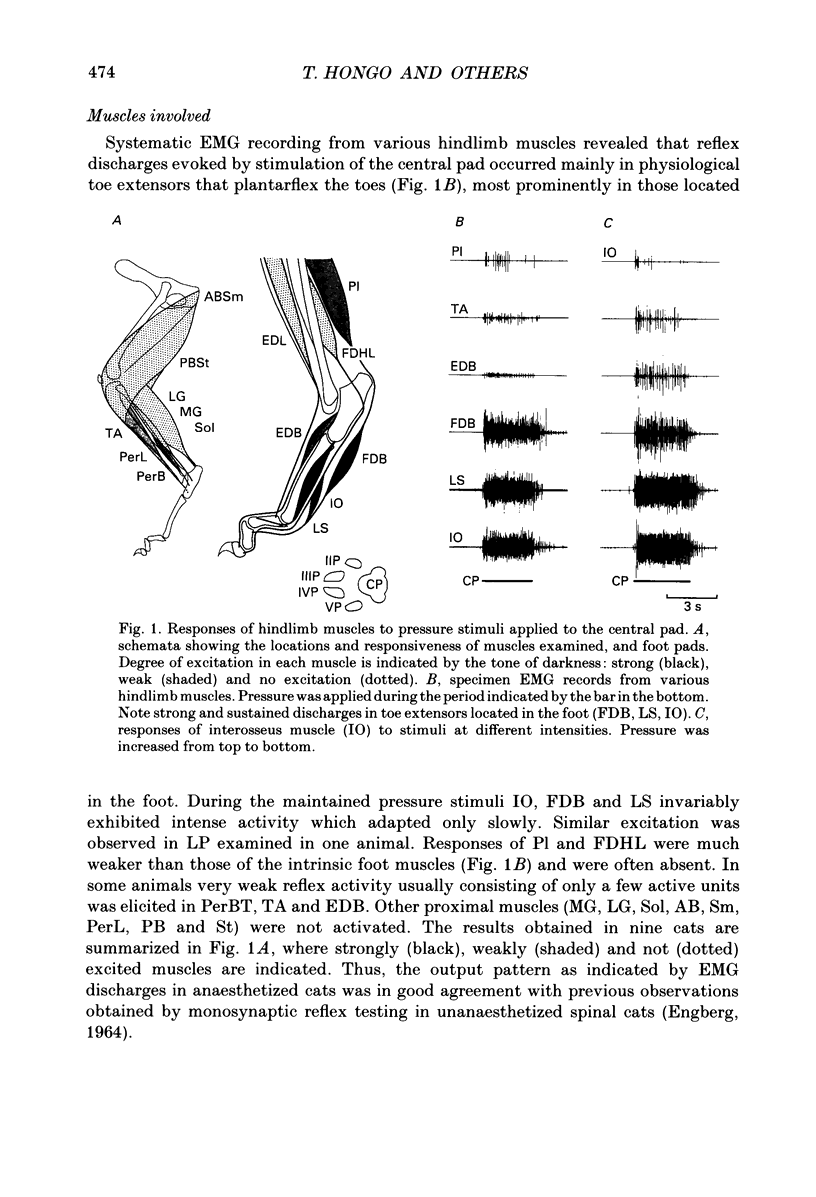
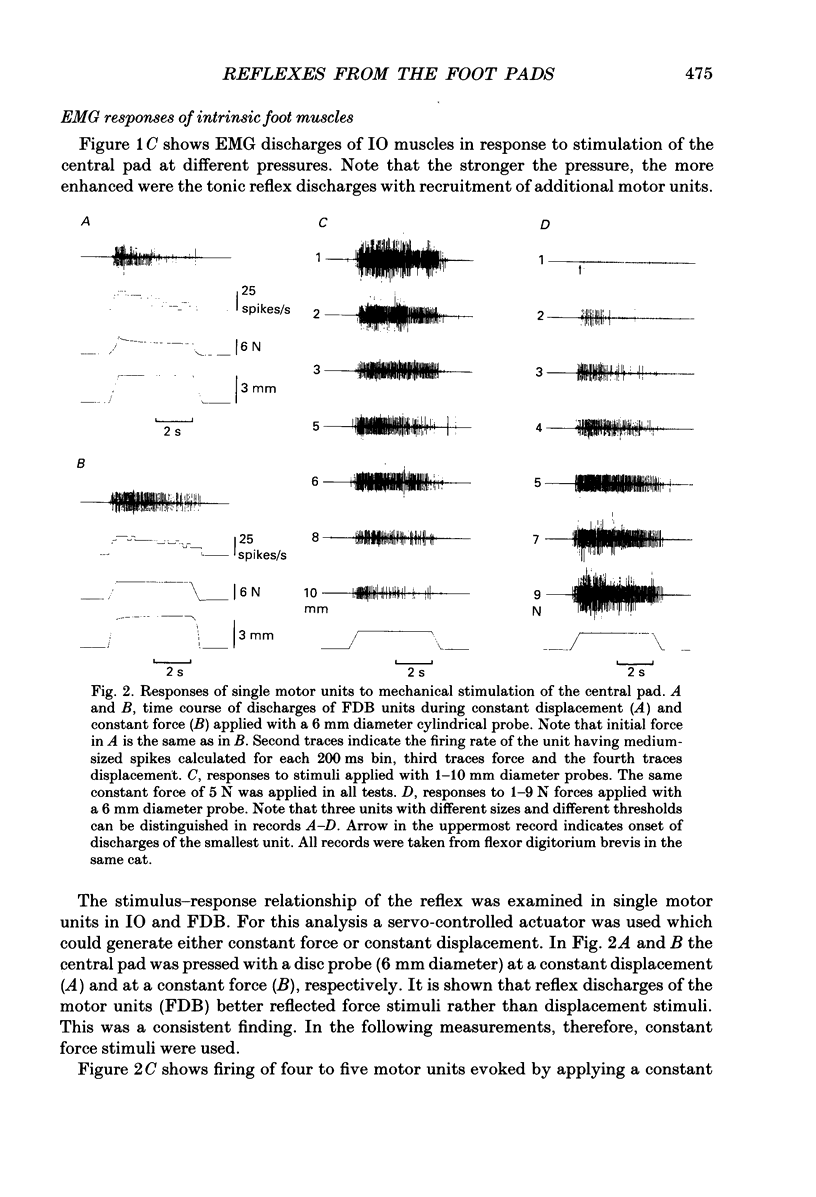
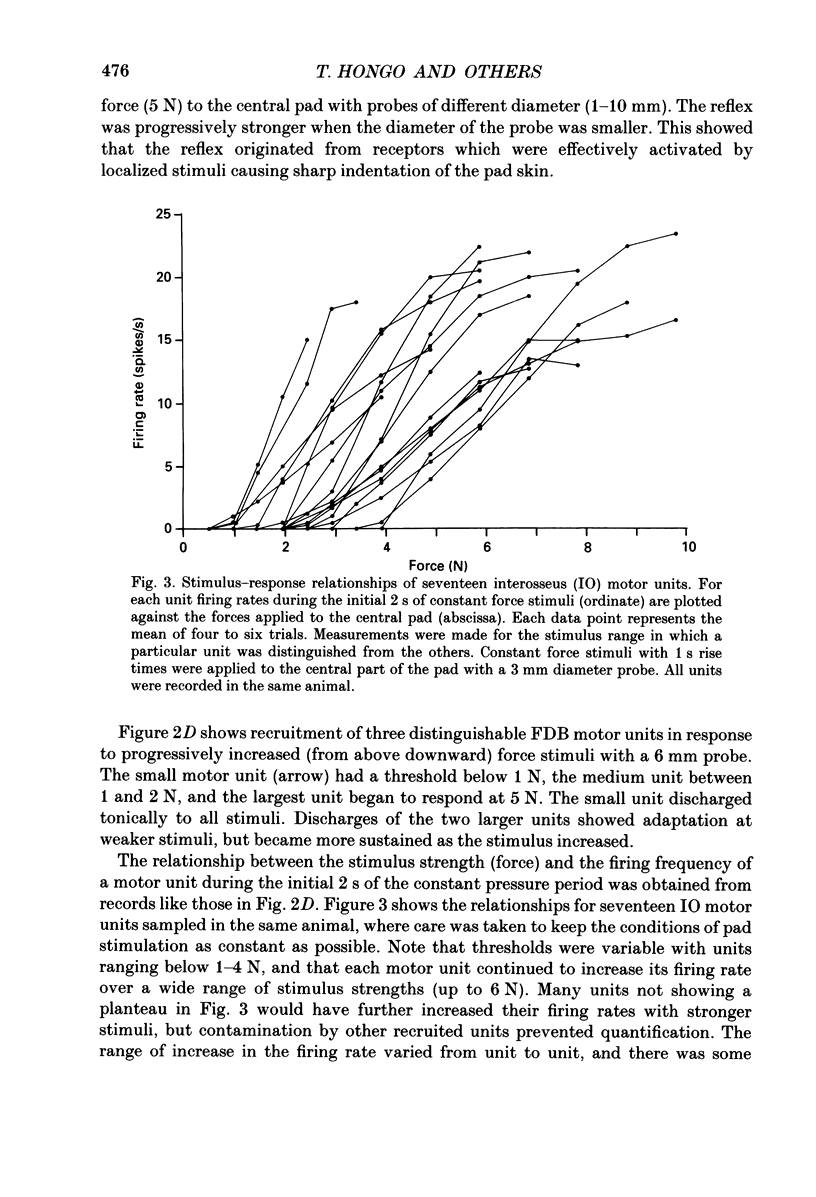
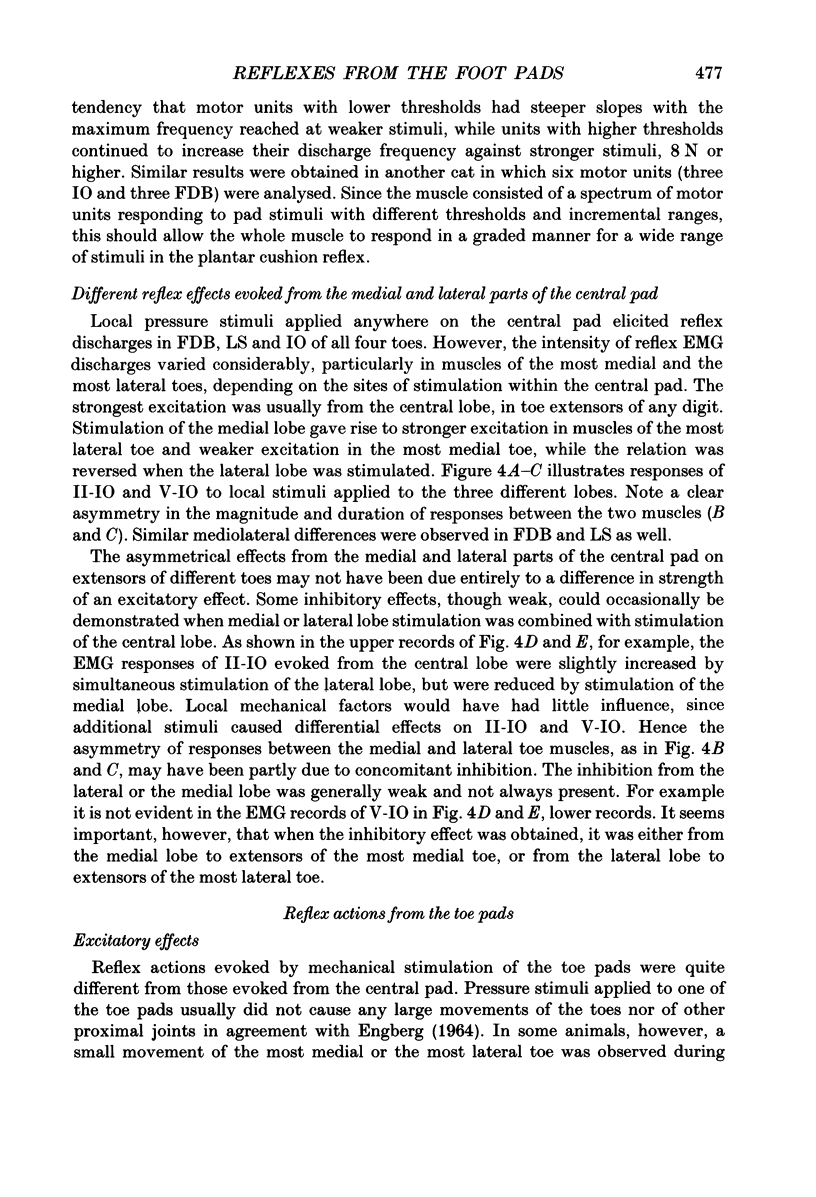
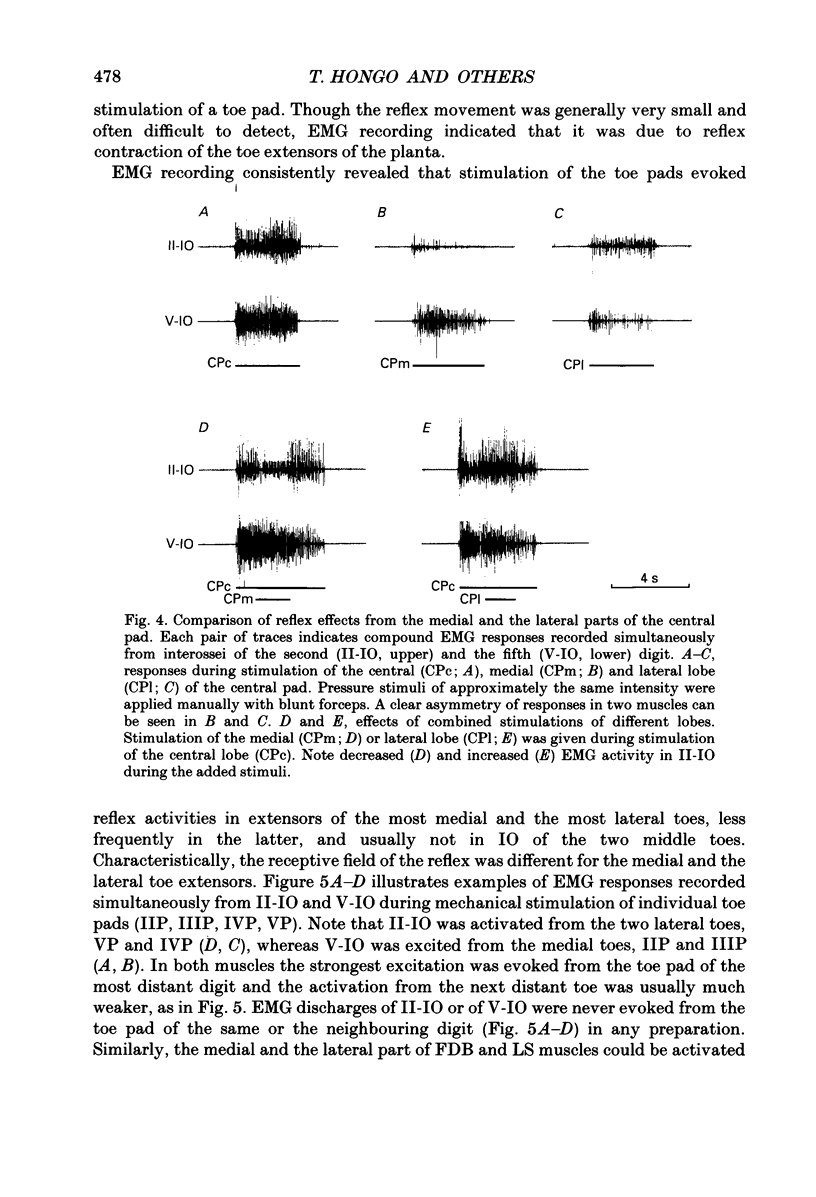
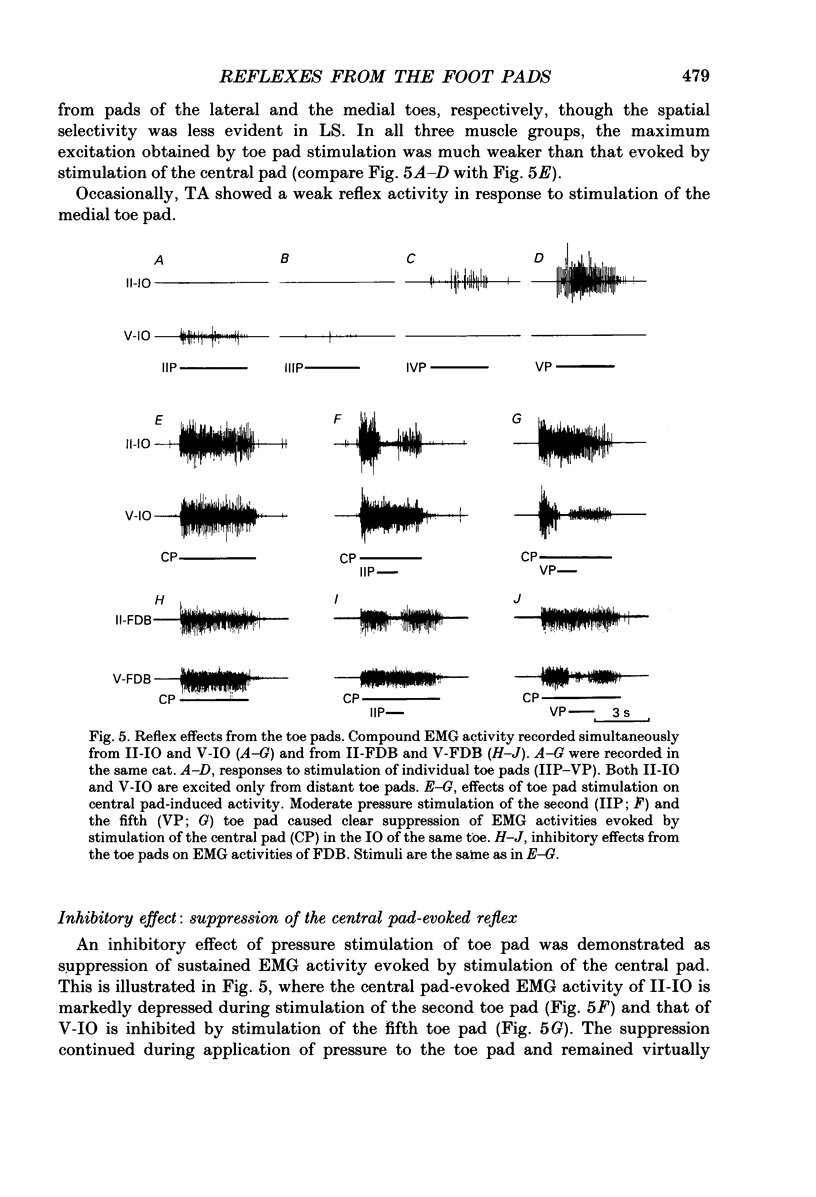
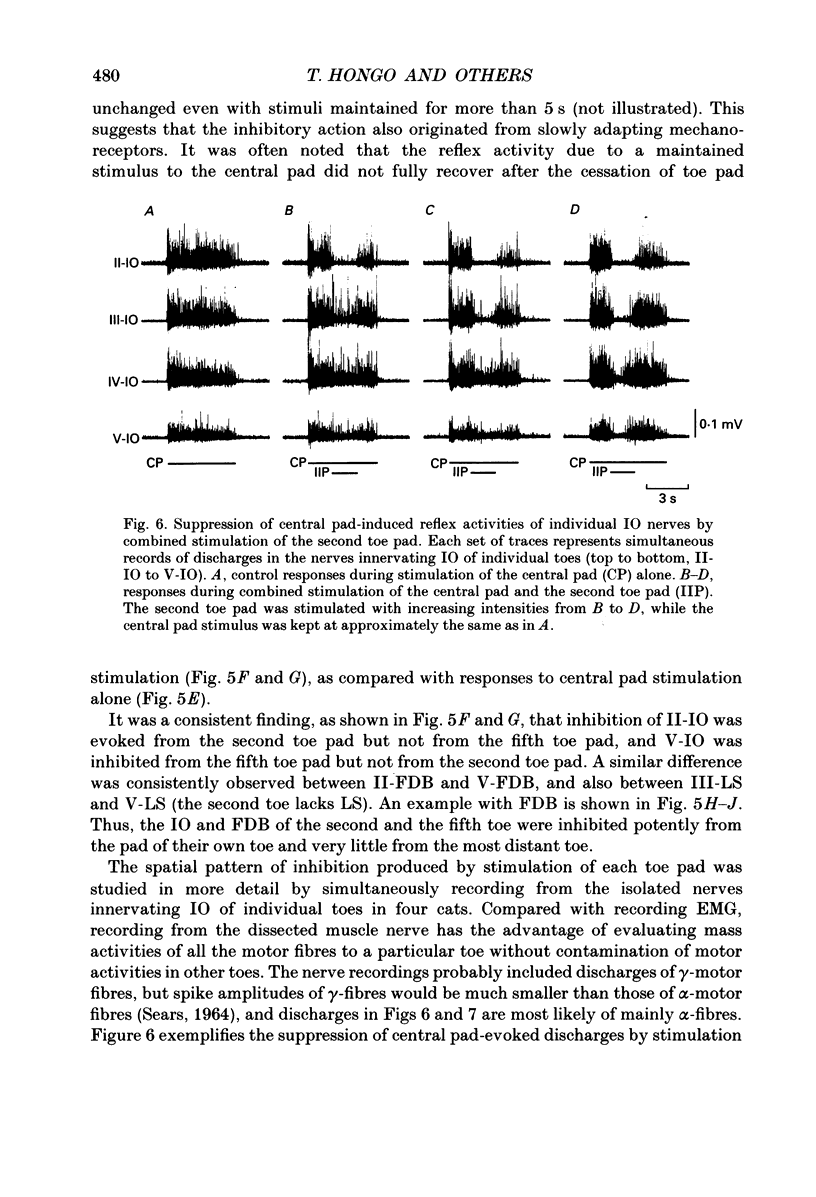
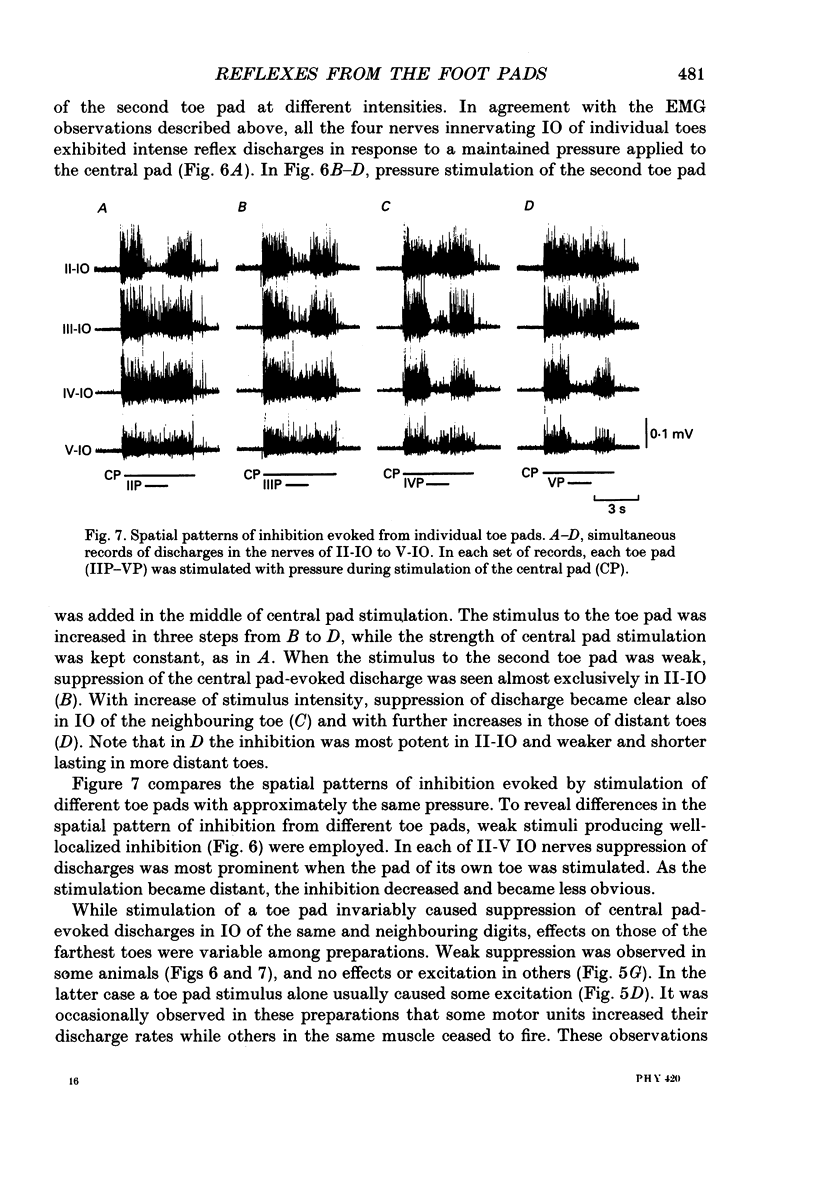
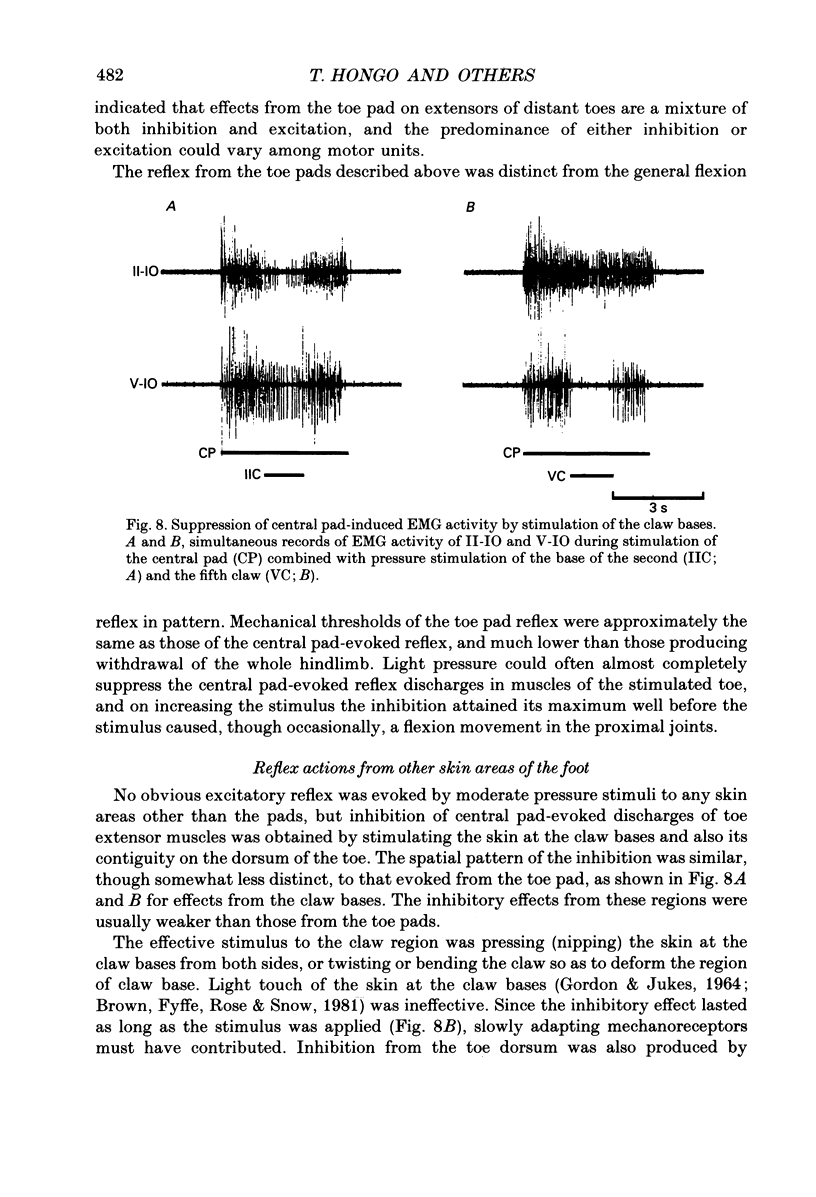
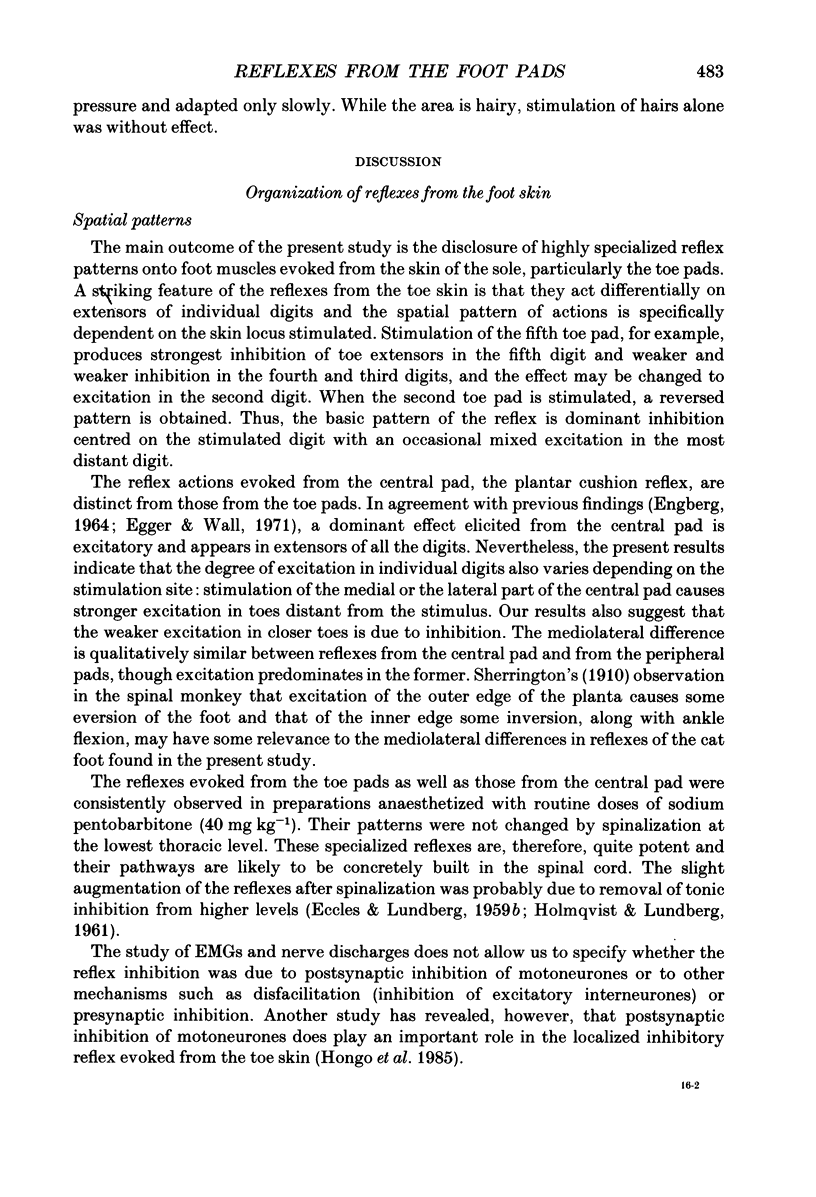
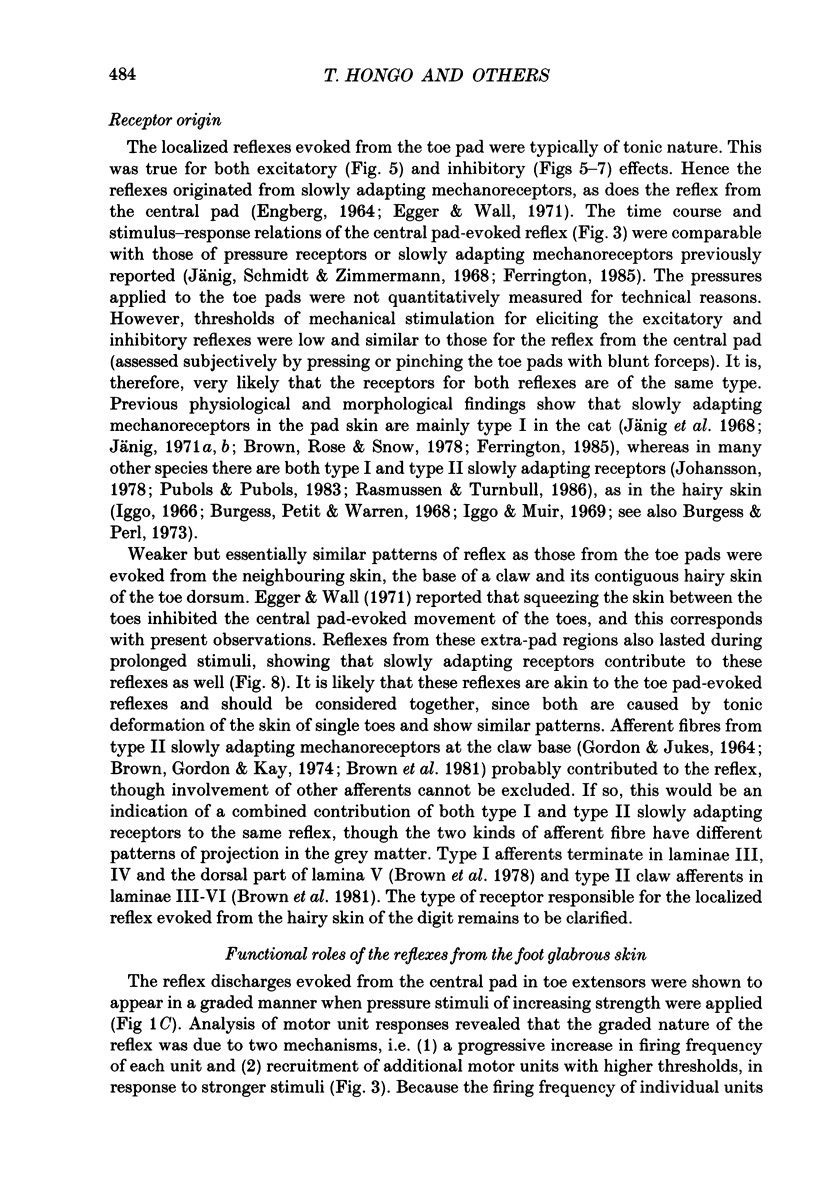
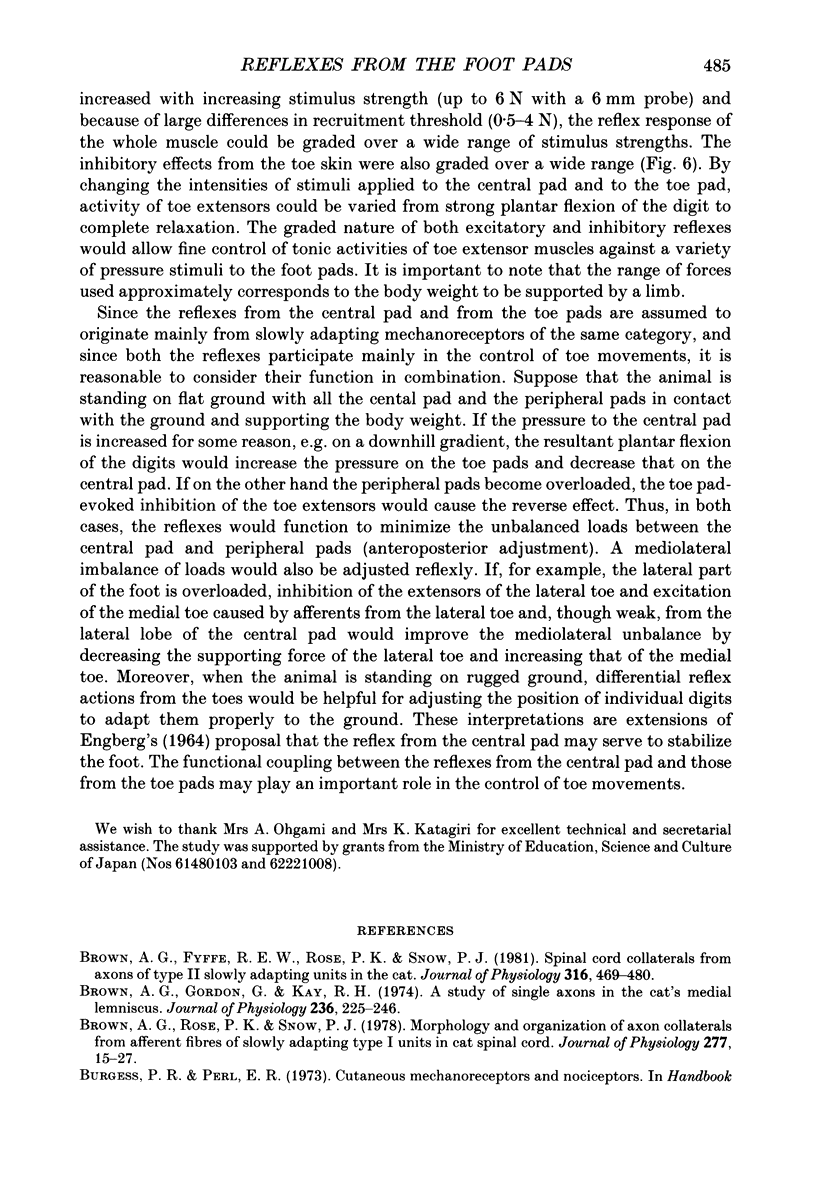
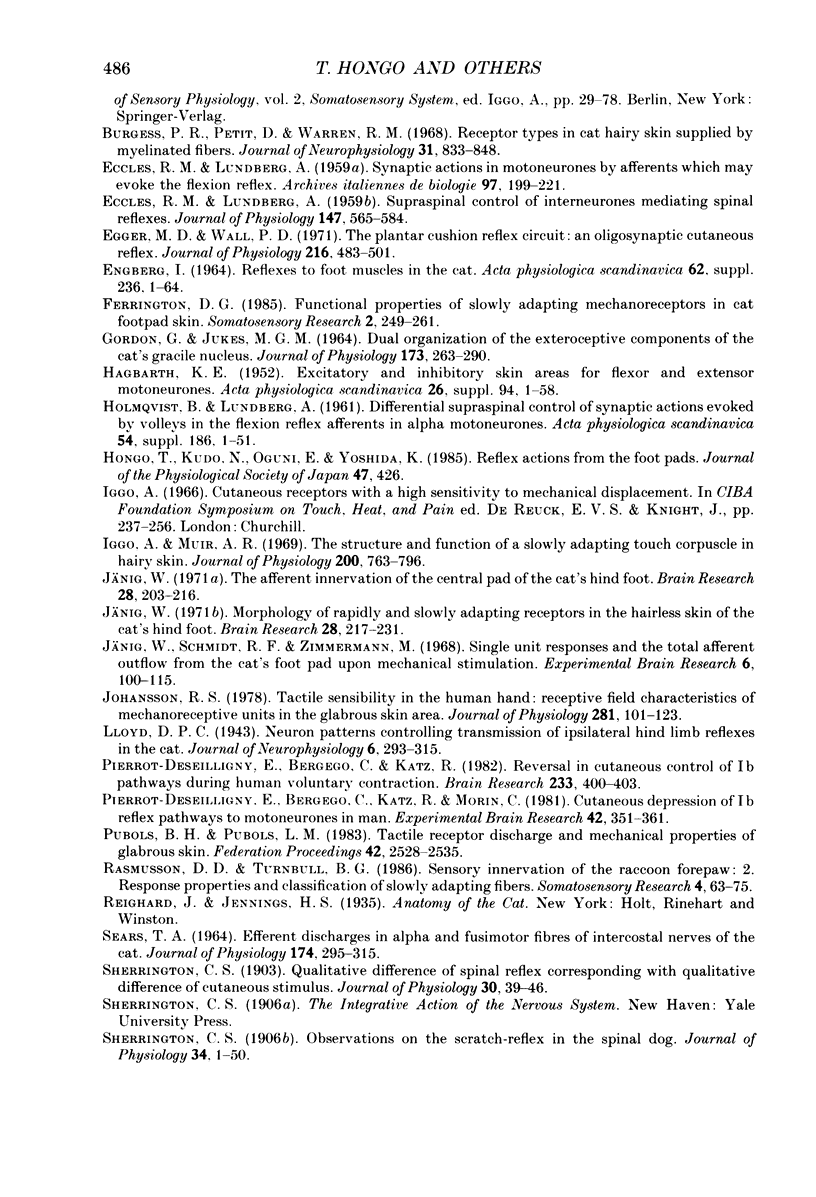

Images in this article
Selected References
These references are in PubMed. This may not be the complete list of references from this article.
- Brown A. G., Fyffe R. E., Rose P. K., Snow P. J. Spinal cord collaterals from axons of type II slowly adapting units in the cat. J Physiol. 1981 Jul;316:469–480. doi: 10.1113/jphysiol.1981.sp013801. [DOI] [PMC free article] [PubMed] [Google Scholar]
- Brown A. G., Gordon G., Kay R. H. A study of single axons in the cat's medial lemniscus. J Physiol. 1974 Jan;236(1):225–246. doi: 10.1113/jphysiol.1974.sp010432. [DOI] [PMC free article] [PubMed] [Google Scholar]
- Brown A. G., Rose P. K., Snow P. J. Morphology and organization of axon collaterals from afferent fibres of slowly adapting type I units in cat spinal cord. J Physiol. 1978 Apr;277:15–27. doi: 10.1113/jphysiol.1978.sp012257. [DOI] [PMC free article] [PubMed] [Google Scholar]
- Burgess P. R., Petit D., Warren R. M. Receptor types in cat hairy skin supplied by myelinated fibers. J Neurophysiol. 1968 Nov;31(6):833–848. doi: 10.1152/jn.1968.31.6.833. [DOI] [PubMed] [Google Scholar]
- ECCLES R. M., LUNDBERG A. Supraspinal control of interneurones mediating spinal reflexes. J Physiol. 1959 Oct;147:565–584. doi: 10.1113/jphysiol.1959.sp006262. [DOI] [PMC free article] [PubMed] [Google Scholar]
- Egger M. D., Wall P. D. The plantar cushion reflex circuit: an oligosynaptic cutaneous reflex. J Physiol. 1971 Jul;216(2):483–501. doi: 10.1113/jphysiol.1971.sp009536. [DOI] [PMC free article] [PubMed] [Google Scholar]
- Ferrington D. G. Functional properties of slowly adapting mechanoreceptors in cat footpad skin. Somatosens Res. 1985;2(3):249–261. doi: 10.3109/07367228509144567. [DOI] [PubMed] [Google Scholar]
- GORDON G., JUKES M. G. DUAL ORGANIZATION OF THE EXTEROCEPTIVE COMPONENTS OF THE CAT'S GRACILE NUCLEUS. J Physiol. 1964 Sep;173:263–290. doi: 10.1113/jphysiol.1964.sp007456. [DOI] [PMC free article] [PubMed] [Google Scholar]
- HAGBARTH K. E. Excitatory and inhibitory skin areas for flexor and extensor motoneurons. Acta Physiol Scand Suppl. 1952;26(94):1–58. [PubMed] [Google Scholar]
- Iggo A., Muir A. R. The structure and function of a slowly adapting touch corpuscle in hairy skin. J Physiol. 1969 Feb;200(3):763–796. doi: 10.1113/jphysiol.1969.sp008721. [DOI] [PMC free article] [PubMed] [Google Scholar]
- Johansson R. S. Tactile sensibility in the human hand: receptive field characteristics of mechanoreceptive units in the glabrous skin area. J Physiol. 1978 Aug;281:101–125. doi: 10.1113/jphysiol.1978.sp012411. [DOI] [PMC free article] [PubMed] [Google Scholar]
- Jänig W. Morphology of rapidly and slowly adapting mechanoreceptors in the hairless skin of the cat's hind foot. Brain Res. 1971 May 7;28(2):217–231. doi: 10.1016/0006-8993(71)90656-1. [DOI] [PubMed] [Google Scholar]
- Jänig W., Schmidt R. F., Zimmermann M. Single unit responses and the total afferent outflow from the cat's foot pad upon mechanical stimulation. Exp Brain Res. 1968;6(2):100–115. doi: 10.1007/BF00239165. [DOI] [PubMed] [Google Scholar]
- Jänig W. The afferent innervation of the central pad of the cat's hind foot. Brain Res. 1971 May 7;28(2):203–216. doi: 10.1016/0006-8993(71)90655-x. [DOI] [PubMed] [Google Scholar]
- Pierrot-Deseilligny E., Bergego C., Katz R., Morin C. Cutaneous depression of Ib reflex pathways to motoneurones in man. Exp Brain Res. 1981;42(3-4):351–361. doi: 10.1007/BF00237500. [DOI] [PubMed] [Google Scholar]
- Pierrot-Deseilligny E., Bergego C., Katz R. Reversal in cutaneous of Ib pathways during human voluntary contraction. Brain Res. 1982 Feb 11;233(2):400–403. doi: 10.1016/0006-8993(82)91213-6. [DOI] [PubMed] [Google Scholar]
- Pubols B. H., Jr, Pubols L. M. Tactile receptor discharge and mechanical properties of glabrous skin. Fed Proc. 1983 Jun;42(9):2528–2535. [PubMed] [Google Scholar]
- Rasmusson D. D., Turnbull B. G. Sensory innervation of the raccoon forepaw: 2. Response properties and classification of slowly adapting fibers. Somatosens Res. 1986;4(1):63–75. doi: 10.3109/07367228609144598. [DOI] [PubMed] [Google Scholar]
- SEARS T. A. EFFERENT DISCHARGES IN ALPHA AND FUSIMOTOR FIBRES OF INTERCOSTAL NERVES OF THE CAT. J Physiol. 1964 Nov;174:295–315. doi: 10.1113/jphysiol.1964.sp007488. [DOI] [PMC free article] [PubMed] [Google Scholar]
- Sherrington C. S. Observations on the scratch-reflex in the spinal dog. J Physiol. 1906 Mar 13;34(1-2):1–50. doi: 10.1113/jphysiol.1906.sp001139. [DOI] [PMC free article] [PubMed] [Google Scholar]
- Sherrington C. S. Qualitative difference of spinal reflex corresponding with qualitative difference of cutaneous stimulus. J Physiol. 1903 Aug 24;30(1):39–46. doi: 10.1113/jphysiol.1903.sp000980. [DOI] [PMC free article] [PubMed] [Google Scholar]



